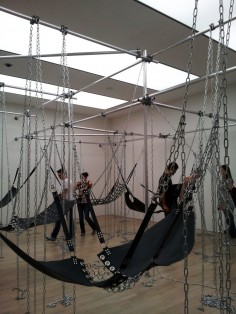MONICA BONVICINI
NEVER AGAIN
source: neoaztlan
Since the nineties, artist Monica Bonvicini has confronted audiences with drawings, installations, videos, and photographs that explore the construction of sexual identity through architecture. Her large-scale sculptural works provoke modernism with sheets of shattered glass and non-functional metal scaffolds and include feisty sexual references with strategic placement of riveted black leather.
Along with Bonvicini’s focus on the gendered nature of the built and building environment comes the notion of power. The force is arguably at work in all facets of our lives but weighs heavily on the ins and outs of the art world. Nowhere is power’s role in the art world more visible than during art fairs and large-scale openings.
Fresh from several art fairs and openings in Europe, Bonvicini shares thoughts about whether fairs are for artists; what she wore (or didn’t) at the 48th Venice Biennale; where modernism always fails; how politics led her to practice art; and how her art work decodes the language of architecture.
.
.
.
.
.
.
source: mymagicalatticblogspot
Monica Bonvicini works in Berlin and Los Angeles. Her work, Stairway to Hell, was installed during the 8th International İstanbul Biennial in 2003, before İstanbul Modern was opened. The laminated glass walls of the stairway with their galvanized iron chains look as if they have been shattered by gunfire. Bonvincini’s destructive renewal of Modernist architecture has been called “radical feminist vandalism”. She contends that a history of oppression lurks behind the flawless facades of many Modernist buildings and opposes the depersonalizing identification of women with objects. However, this work is more than a simple rejection of Modernist authoritarianism. Almost paradoxically, the work is closely associated with Bonvicini’s interest in the surfaces and qualities of Modernist architecture. It’s possible to say that she is inspired and perhaps even entranced by the style. Ultimately, her fractured glass surfaces and web-like structures are intriguing and their aggressiveness is certainly contained within the logic of Modernism.


